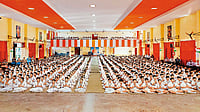Baljeet Kaur loves Punjabi singers Kanwal Gerewal and Babbu Mann and their soulful music. Gerewal’s new song “Nahi Mukya Ghol Kisani” has worked as a therapy for the 28-year-old farmer leader from Punjab, who has been protesting, along with lakhs of farmers against the three farm laws passed by the Central government in September last year.
On November 19, when Prime Minister Narendra Modi made the announcement of repealing the three contentious farm laws, Baljeet Kaur was preparing for a weekly meeting with her colleagues to chalk out plans for their march to Parliament on the first-year anniversary of the farm protests.
“I felt proud that I was part of a historic protest, which we won,” she beams. The farmers’ protest, touted as one of the largest in the history of Independent India, first erupted in Punjab after the farm bills were passed.
From a homemaker to a union leader, Kaur’s world has changed in a drastic way over the last one year. A mother of three daughters, she decided to leave the comforts of her home to join protesting farmers because “it was the question of our existence and I couldn’t stop myself from joining the agitation.” After a year of joining Bhartiya Kisan Union (Krantikari), she has now risen to leadership position and is a member of the district committee of the union.
In her village Makhu, in Ferozepur district of Punjab, Kaur holds a meeting of 50-odd women farmers every week. Though the meetings are mostly about mobilizing women for the protests in the Delhi borders, sometimes they veer into resolving family feuds and concerns of women regarding work and wages.
With more women farmers joining the rank and file of protestors in large numbers, conversations about breaking the barriers of patriarchy are getting louder too. “It’s for the first time that women are getting a chance to share equal space with men. How can we hold ourselves back? Earlier, men used to tell women what to do. Now it’s women who teach others how to lead protests. Women have realised that if we can fight the government and win, nothing is impossible,” says Kaur.
The emergence of women leaders from the heartlands of Punjab, Haryana and Uttar Pradesh, is changing the political, social and gender equations, says Sukhwinder Kaur, state committee member of the BKU (Krantikari).
ALSO READ: 'Hum Dekhenge': Times When India Protested

Leading from the front Saima Khan and Kahkashan Riyaz at Shaheen Bagh
“We are seeing a huge number of women coming into leadership positions. Gender roles are also being reviewed inside families because of the churning. Women are also discussing other issues such as the right to land and wages. Menfolk have now recognised the power of women to lead the battle,” says Kaur. Debates on addressing the concerns of the ‘invisible women farmer’ and the need to fight for her rights are happening for the first time.
Another farmer leader Rajbala Yadav, who hails from Rewari in Haryana, says that the huge presence of women in the ongoing protests is encouraging. “There is no doubt that women farmers work more than men and don multiple hats. Now that women have entered the leadership space, all these issues are being taken up,” says Yadav.
Social activist Medha Patkar who led the ‘Save Narmada Movement’, says that though women farmers play a great role in agriculture, several critical issues are yet to be addressed. “On International Women’s Day, there were about 40,000 and more women moving around the protest sites at Delhi’s borders. When they are not at the borders, they take care of the farm and the families. Slowly, they are coming into the leadership too,” says Patkar.
Medha Patkar belongs to the league of women, who created history with their unique style of protest. Patkar spearheaded one of the longest protests against dam projects across the Narmada River, which threatened to displace thousands of people. Whether it’s Chipko Movement in 1973, or the Anti-Nuclear Protests in Tamil Nadu in 1980 or the Bhopal Disaster in 1984, women’s role in leading these movements has been nothing short of phenomenal.
“In any protests, the directly affected populations are always at the forefront. That’s true for farmers’ protests or anti-CAA agitations. Women have played a significant role in all the protests because it directly affects them,” says Patkar.
Though history is replete with instances where women played a key role in historic protests, the memory of iconic Shaheen Bagh protests is still fresh in the minds of people.
One of the longest sit-in protests, predominantly led by Muslim women, Shaheen Bagh has earned its place in history. The protest was helmed by a handful of women in Shaheen Bagh, Delhi, in mid-December 2019 against the Citizenship (Amendment) Act.

Women farmers in a Kisan Sansad at Jantar Mantar, New Delhi.
Saima Khan, who participated in the sit-in protest from the beginning, says that Shaheen Bagh has given a template for the future protests. She decided to join the protests after witnessing police brutality on the students of Jamia Milia University, close to her house.
“When CAA was passed in Parliament, I was shocked. This is my homeland. My grandparents and their ancestors all lived here. When I saw the violence against the students, I decided enough was enough,” says the 34-year-old mother of four. Shaheen Bagh may have fallen silent and the protest artwork may have been buried under coats of white paint, but the fire is still alive, says Khan.
“We broke the myth that Muslim women are suppressed by our religion, that they don’t raise their voice. We showed our power to the world through peaceful protests,” she adds. Shaheen Bagh was a learning ground for Khan. It taught her how to fight bigotry and misogyny. And she discovered solidarity and identity through it.
For another protestor—Kahkashan Riyaz, the 101-day protest brought a new perspective to her life. From a homemaker to a full-time protestor, the journey has felt fulfilling to Riyaz. She feels that Shaheen Bagh showed the way for many others like her. “Shaheen Bagh will be a template for all the protests in the future. It’s not about the outcome, but the way women led the sit-in,” says the mother of two. The movement has produced umpteen women leaders. Women are continuing their fight, aligning with the agitating farmers and other like-minded forces, she says.
“During the anti-CAA protest, every woman was a leader, she wouldn’t wait for anyone to lead her. She found her foothold. Shaheen Bagh has empowered us to lead our own battle. We can’t be fearful and run away. If there’s a second edition of Shaheen Bagh, it will be even more powerful than its predecessor,” says Riyaz.
While the anti-CAA protests saw huge participation of the student community, especially women, the subsequent crackdown by police and arrests of many students have sparked debates on the right to hold protests in a democratic manner.
Safoora Zargar, a student at the Jamia Millia Islamia university in New Delhi, was one of them. She was arrested by Delhi Police on charges of her ‘alleged role as conspirator’ behind the riots that broke out in North-East Delhi in February 2020. The 27-year-old was three months pregnant at the time of her arrest.
Zargar was charged under the Unlawful Activities (Prevention) Act (UAPA), and kept in jail for over three months. “We were very hopeful of bail. But then we got to know that police had invoked UAPA against me. For a long time, I lost hope of getting bail. But people spoke for me. The State had to concede and I got relief from the courts. It shows the power of protests,” says Zargar.
Her arrest sparked outrage and invited criticism from rights groups. After 75 days of ordeal in prison, Zargar was granted bail. She feels that increased participation of women in protests will desexualise protests and provide women a platform to air their critical issues.
“We saw women participating in huge numbers in Shaheen Bagh. We also saw the same in the kisan andolan. I think increased participation of women has led to more gender-inclusive protests, especially in Shaheen Bagh, where women were also decision makers. It has enabled women to claim democratic spaces as their own,” she says.
Zargar feels it’s high time that protests be decriminalised. “Though women led a powerful indefinite sit-in at Shaheen Bagh, they were made to feel morally and socially culpable. Do different people in India have different kinds of rights to protest?” she wonders. However, she feels hopeful with the government deciding to repeal the farm laws. “Protests are the lifeline of democracy. The climbdown of the government will tilt the power back towards the people,” she says.
(This appeared in the print edition as "Wonder Women")
ALSO READ

























